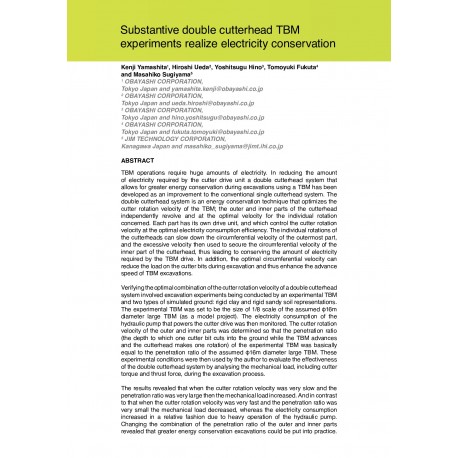Cart
0
0
No document
0,00 €
Total
Document successfully added to your shopping cart
Quantity
Total
There are 0 items in your cart.
There is 1 item in your cart.
Total documents
Total shipping
To be determined
Total
Search & filter
Search for a publication
Search & filter
Substantive double cutterhead TBM experiments realize electricity conservation
601_substantive_double_cutterhea
K. Yamashita / H. Ueda / Y. Hino / T. Fukuta / M. Sugiyama
TBM operations require huge amounts of electricity. In reducing the amount of electricity required by the cutter drive unit a double cutterhead system that allows for greater energy conservation during excavations using a TBM has been developed as an improvement to the conventional single cutterhead system. The double cutterhead system is an energy conservation technique that optimizes the cutter rotation velocity of the TBM; the outer and inner parts of the cutterhead independently revolve and at the optimal velocity for the individual rotation concerned. Each part has its own drive unit, and which control the cutter rotation velocity at the optimal electricity consumption efficiency. The individual rotations of the cutterheads can slow down the circumferential velocity of the outermost part, and the excessive velocity then used to secure the circumferential velocity of the inner part of the cutterhead, thus leading to conserving the amount of electricity required by the TBM drive. In addition, the optimal circumferential velocity can reduce the load on the cutter bits during excavation and thus enhance the advance speed of TBM excavations.Verifying the optimal combination of the cutter rotation velocity of a double cutterhead system involved excavation experiments being conducted by an experimental TBM and two types of simulated ground: rigid clay and rigid sandy soil representations. The experimental TBM was set to be the size of 1/8 scale of the assumed φ16m diameter large TBM (as a model project). The electricity consumption of the hydraulic pump that powers the cutter drive was then monitored. The cutter rotation velocity of the outer and inner parts was determined so that the penetration ratio (the depth to which one cutter bit cuts into the ground while the TBM advances and the cutterhead makes one rotation) of the experimental TBM was basically equal to the penetration ratio of the assumed φ16m diameter large TBM. These experimental conditions were then used by the author to evaluate the effectiveness of the double cutterhead system by analysing the mechanical load, including cutter torque and thrust force, during the excavation process.The results revealed that when the cutter rotation velocity was very slow and the penetration ratio was very large then the mechanical load increased. And in contrast to that when the cutter rotation velocity was very fast and the penetration ratio was very small the mechanical load decreased, whereas the electricity consumption increased in a relative fashion due to heavy operation of the hydraulic pump. Changing the combination of the penetration ratio of the outer and inner parts revealed that greater energy conservation excavations could be put into practice.




